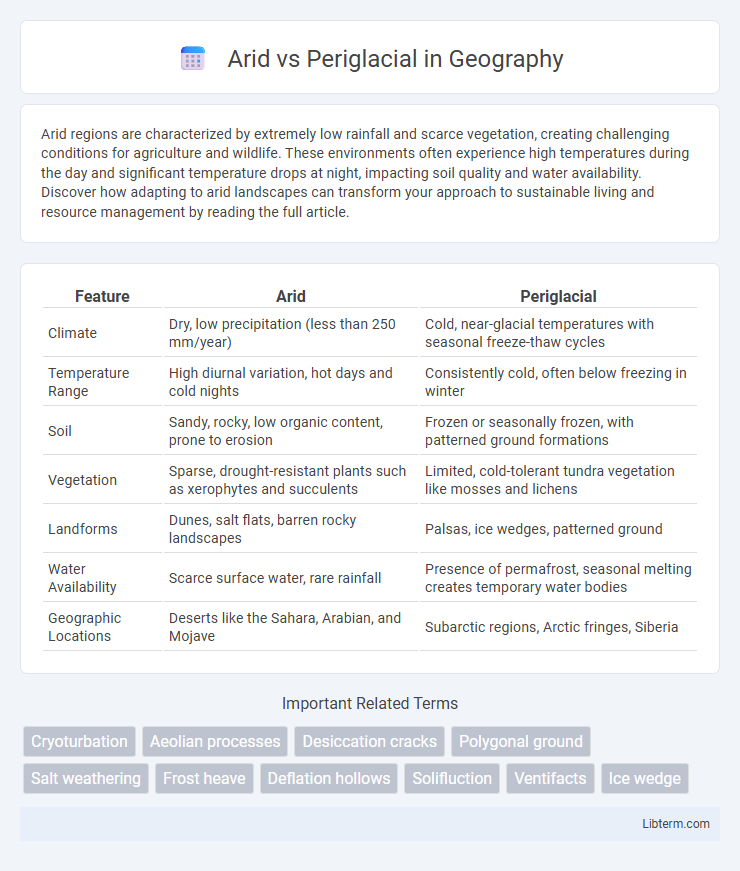Arid regions are characterized by extremely low rainfall and scarce vegetation, creating challenging conditions for agriculture and wildlife. These environments often experience high temperatures during the day and significant temperature drops at night, impacting soil quality and water availability. Discover how adapting to arid landscapes can transform your approach to sustainable living and resource management by reading the full article.
Table of Comparison
| Feature | Arid | Periglacial |
|---|---|---|
| Climate | Dry, low precipitation (less than 250 mm/year) | Cold, near-glacial temperatures with seasonal freeze-thaw cycles |
| Temperature Range | High diurnal variation, hot days and cold nights | Consistently cold, often below freezing in winter |
| Soil | Sandy, rocky, low organic content, prone to erosion | Frozen or seasonally frozen, with patterned ground formations |
| Vegetation | Sparse, drought-resistant plants such as xerophytes and succulents | Limited, cold-tolerant tundra vegetation like mosses and lichens |
| Landforms | Dunes, salt flats, barren rocky landscapes | Palsas, ice wedges, patterned ground |
| Water Availability | Scarce surface water, rare rainfall | Presence of permafrost, seasonal melting creates temporary water bodies |
| Geographic Locations | Deserts like the Sahara, Arabian, and Mojave | Subarctic regions, Arctic fringes, Siberia |
Introduction to Arid and Periglacial Environments
Arid environments are characterized by extremely low precipitation, often less than 250 mm annually, leading to sparse vegetation and significant soil erosion. Periglacial environments exist adjacent to glaciers, where freezing and thawing cycles dominate, causing unique geomorphological features like frost heave and patterned ground. Both environments influence landscape formation but through distinct climatic and hydrological processes that shape soil, sediment, and vegetation patterns.
Defining Arid Regions
Arid regions are defined by their extremely low annual precipitation, typically less than 250 millimeters, resulting in limited vegetation and sparse water resources. These areas experience high evaporation rates that exceed rainfall, leading to dry soil conditions and desert landscapes. Understanding arid zones is crucial for distinguishing them from periglacial environments, which are characterized by cold temperatures and freeze-thaw processes rather than dryness.
Characteristics of Periglacial Zones
Periglacial zones exhibit distinctive characteristics including intense freeze-thaw cycles, the presence of permafrost, and patterned ground formations such as ice wedges and solifluction lobes. These areas experience extreme seasonal temperature variations resulting in soil and rock movement, creating unique landforms and influencing hydrology. Vegetation is typically sparse, adapted to cold, dry conditions with limited growing seasons, distinguishing periglacial environments from arid zones dominated by heat and drought.
Climate Differences: Arid vs Periglacial
Arid climates are characterized by extremely low precipitation, often less than 250 mm annually, leading to dry, desert-like conditions with high temperature variability between day and night. Periglacial climates exist near glacial areas and experience extremely cold temperatures, frequent freeze-thaw cycles, and limited liquid water availability due to persistent freezing conditions. While arid regions have minimal moisture and often intense heat, periglacial zones have cold temperatures and frozen ground, significantly impacting soil processes and ecosystem development.
Soil Formation and Composition
Arid soils typically exhibit low organic matter and high mineral content due to limited moisture, leading to slow chemical weathering and accumulation of soluble salts and carbonates. Periglacial soils develop under cold, freeze-thaw conditions, resulting in patterned ground, cryoturbation, and accumulation of ice-rich layers that impact soil texture and organic carbon distribution. Soil formation in arid environments emphasizes evaporation-driven salt deposition, while periglacial soils reflect processes of frost action and seasonal temperature fluctuations.
Landforms: Erosional and Depositional Features
Arid landforms are characterized by erosional features such as desert pavements, inselbergs, and yardangs formed by wind abrasion, while depositional features include alluvial fans, dunes, and playa lakes created by intermittent water and wind deposition. Periglacial environments exhibit erosional landforms like patterned ground and solifluction lobes caused by freeze-thaw cycles and frost heave, with depositional features including ice-wedge casts and loess deposits resulting from sediment accumulation in cold climates. These contrasting processes highlight the dominance of aeolian forces in arid zones and cryogenic mechanisms in periglacial regions shaping their unique landscapes.
Vegetation and Adaptation Strategies
Arid environments typically feature sparse vegetation dominated by drought-resistant plants like cacti and xerophytes, which adapt through deep root systems and water storage tissues. Periglacial regions support tundra vegetation consisting mainly of mosses, lichens, and hardy shrubs adapted to cold, nutrient-poor soils and seasonal freeze-thaw cycles. Adaptation strategies in arid zones emphasize water conservation, while periglacial plants employ mechanisms to withstand freezing temperatures and short growing seasons.
Hydrology and Water Dynamics
Arid regions experience low precipitation and high evapotranspiration rates, resulting in limited surface water flow and intermittent or ephemeral rivers, significantly influencing groundwater recharge and water availability. Periglacial environments are characterized by seasonal freeze-thaw cycles that impact subsurface ice distribution and create patterned ground, affecting hydrological processes like soil moisture retention and surface runoff. The contrasting water dynamics in these zones reflect their distinct climatic controls, with arid zones dominated by scarcity and evapotranspiration, while periglacial zones are influenced by temperature fluctuations and freeze-thaw hydrology.
Human Activities and Environmental Impact
Human activities in arid regions often involve extensive water extraction and irrigation, leading to soil salinization and desertification that degrade fragile ecosystems. In periglacial environments, infrastructure development and resource extraction disrupt permafrost stability, accelerating thawing and releasing greenhouse gases such as methane. Both climatic zones face significant environmental impacts from human interventions, necessitating sustainable management strategies to mitigate ecosystem degradation and climate feedback effects.
Conclusion: Comparing Arid and Periglacial Landscapes
Arid landscapes are dominated by minimal precipitation, sparse vegetation, and processes like wind erosion, creating features such as sand dunes and rocky plateaus. Periglacial landscapes, influenced by freeze-thaw cycles near glacial areas, exhibit patterned ground, solifluction lobes, and ice wedge polygons due to intense frost activity. The primary contrast lies in climatic conditions driving distinct geomorphological processes, resulting in markedly different landforms and ecosystem characteristics.
Arid Infographic

 libterm.com
libterm.com